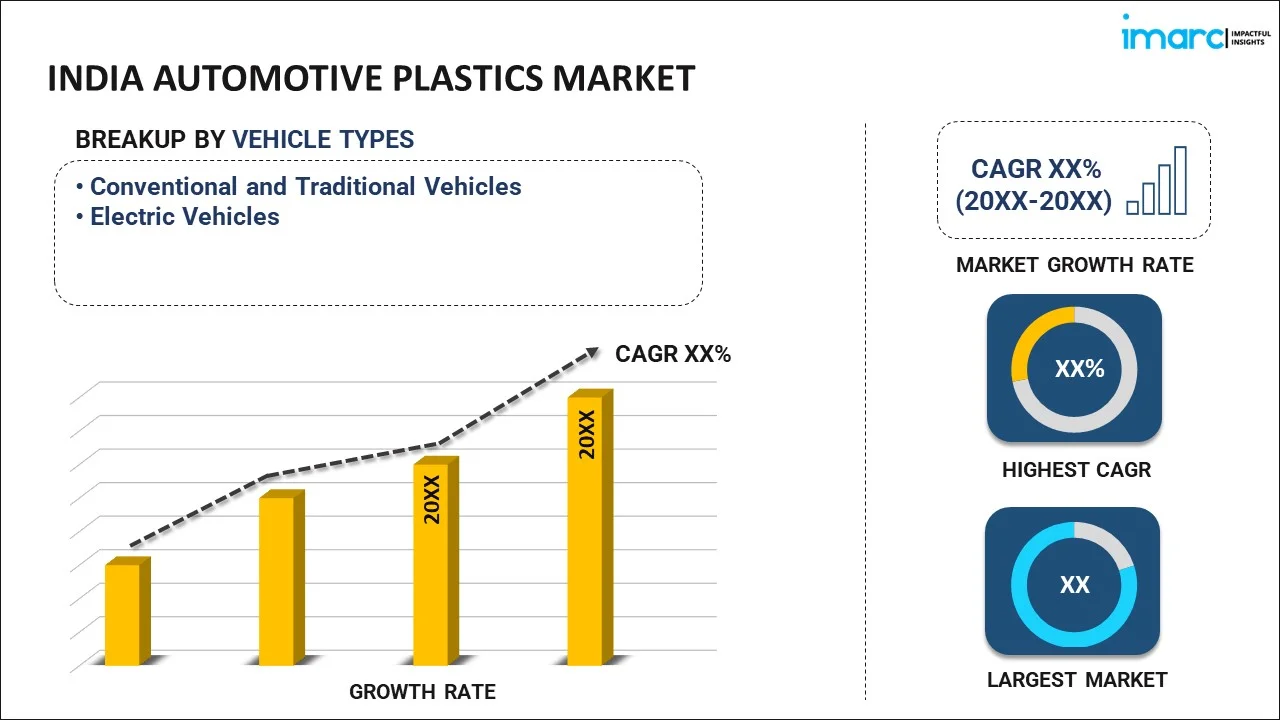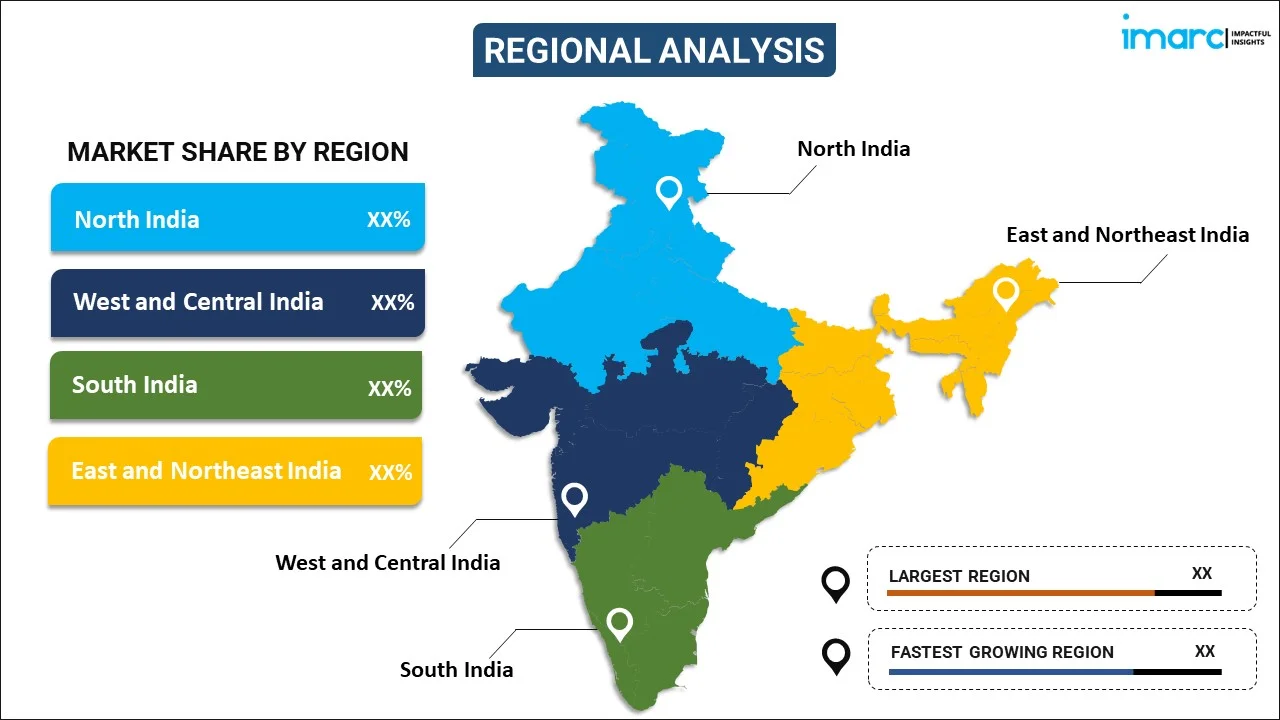
India Automotive Plastics Market Report by Vehicle Type (Conventional and Traditional Vehicles, Electric Vehicles), Material (Polyethylene (PE), Polypropylene (PP), Polyvinyl Chloride (PVC), Acrylonitrile Butadiene Styrene (ABS), Polyurethane (PU), Polymethyl Methacrylate (PMMA), Polycarbonate (PC), Polyamide, and Others), Application (Powertrain, Electrical Components, Interior Furnishings, Exterior Furnishings, Under the Hood, Chassis), and Region 2025-2033
Market Overview:
India automotive plastics market size reached USD 1,441.5 Million in 2024. Looking forward, IMARC Group expects the market to reach USD 2,162.1 Million by 2033, exhibiting a growth rate (CAGR) of 4.61% during 2025-2033. The increasing demand for plastics, which offer greater design flexibility compared to traditional materials, enabling automakers to create innovative and aerodynamic designs, is driving the market.
|
Report Attribute
|
Key Statistics
|
|---|---|
|
Base Year
|
2024 |
|
Forecast Years
|
2025-2033
|
|
Historical Years
|
2019-2024
|
| Market Size in 2024 | USD 1,441.5 Million |
| Market Forecast in 2033 | USD 2,162.1 Million |
| Market Growth Rate (2025-2033) | 4.61% |
Automotive plastics refer to a wide range of synthetic polymers used in the manufacturing of various components within the automotive industry. These materials offer lightweight, durable, and versatile solutions for designing components such as bumpers, interior panels, dashboards, and exterior body parts. The use of automotive plastics has become integral in enhancing fuel efficiency by reducing the overall weight of vehicles, thereby contributing to better environmental performance. Additionally, plastics provide design flexibility, allowing for innovative and aerodynamic vehicle shapes. Furthermore, these materials play a crucial role in improving safety by absorbing impact energy during collisions. Their corrosion resistance and ability to withstand harsh environmental conditions make them ideal for exterior applications. With advancements in polymer technology, automotive plastics continue to evolve, offering solutions that meet stringent safety standards, environmental concerns, and the industry's demand for efficient and sustainable materials.
India Automotive Plastics Market Trends:
The automotive plastics market in India is experiencing robust growth, primarily driven by several key factors. Firstly, the increasing emphasis on lightweight materials in the automotive industry has propelled the demand for plastics, as they offer a compelling solution to reduce overall vehicle weight. This emphasis is interconnected with the growing regional focus on fuel efficiency and environmental sustainability, where lightweight plastics contribute to improved fuel efficiency and reduced emissions. Furthermore, the escalating consumer preference for advanced safety features has augmented the demand for automotive plastics. Plastics play a pivotal role in the manufacturing of safety components, such as airbags, seat belts, and bumpers, contributing to enhanced vehicle safety standards. Additionally, the continuous advancements in polymer technologies have expanded the application scope of plastics in the automotive sector, fostering innovation and creating new opportunities. Moreover, stringent regulations pertaining to vehicle emissions and safety standards have mandated automakers to explore alternative materials, further propelling the adoption of automotive plastics. The ongoing trend toward electric vehicles (EVs) also significantly influences the market, as plastics are crucial in the production of lightweight components essential for electric vehicle design. In conclusion, the automotive plastics market in India is propelled by a confluence of factors, including the pursuit of lightweighting, safety advancements, technological innovations, and regulatory imperatives.
India Automotive Plastics Market Segmentation:
IMARC Group provides an analysis of the key trends in each segment of the market, along with forecasts at the country level for 2025-2033. Our report has categorized the market based on vehicle type, material, and application.
Vehicle Type Insights:

- Conventional and Traditional Vehicles
- Electric Vehicles
The report has provided a detailed breakup and analysis of the market based on the vehicle type. This includes conventional and traditional vehicles and electric vehicles.
Material Insights:
- Polyethylene (PE)
- Polypropylene (PP)
- Polyvinyl Chloride (PVC)
- Acrylonitrile Butadiene Styrene (ABS)
- Polyurethane (PU)
- Polymethyl Methacrylate (PMMA)
- Polycarbonate (PC)
- Polyamide
- Others
A detailed breakup and analysis of the market based on the material have also been provided in the report. This includes polyethylene (PE), polypropylene (PP), polyvinyl chloride (PVC), acrylonitrile butadiene styrene (ABS), polyurethane (PU), polymethyl methacrylate (PMMA), polycarbonate (PC), polyamide, and others.
Application Insights:
- Powertrain
- Electrical Components
- Interior Furnishings
- Exterior Furnishings
- Under the Hood
- Chassis
The report has provided a detailed breakup and analysis of the market based on the application. This includes powertrain, electrical components, interior furnishings, exterior furnishings, under the hood, and chassis.
Regional Insights:

- North India
- West and Central India
- South India
- East and Northeast India
The report has also provided a comprehensive analysis of all the major regional markets, which include North India, West and Central India, South India, and East and Northeast India.
Competitive Landscape:
The market research report has also provided a comprehensive analysis of the competitive landscape. Competitive analysis such as market structure, key player positioning, top winning strategies, competitive dashboard, and company evaluation quadrant has been covered in the report. Also, detailed profiles of all major companies have been provided.
India Automotive Plastics Market Report Coverage:
| Report Features | Details |
|---|---|
| Base Year of the Analysis | 2024 |
| Historical Period | 2019-2024 |
| Forecast Period | 2025-2033 |
| Units | Million USD |
| Scope of the Report | Exploration of Historical Trends and Market Outlook, Industry Catalysts and Challenges, Segment-Wise Historical and Future Market Assessment:
|
| Vehicle Types Covered | Conventional and Traditional Vehicles, Electric Vehicles |
| Materials Covered | Polyethylene (PE), Polypropylene (PP), Polyvinyl Chloride (PVC), Acrylonitrile Butadiene Styrene (ABS), Polyurethane (PU), Polymethyl Methacrylate (PMMA), Polycarbonate (PC), Polyamide, Others |
| Applications Covered | Powertrain, Electrical Components, Interior Furnishings, Exterior Furnishings, Under the Hood, Chassis |
| Regions Covered | North India, West and Central India, South India, East and Northeast India |
| Customization Scope | 10% Free Customization |
| Post-Sale Analyst Support | 10-12 Weeks |
| Delivery Format | PDF and Excel through Email (We can also provide the editable version of the report in PPT/Word format on special request) |
Key Questions Answered in This Report:
- How has the India automotive plastics market performed so far and how will it perform in the coming years?
- What has been the impact of COVID-19 on the India automotive plastics market?
- What is the breakup of the India automotive plastics market on the basis of vehicle type?
- What is the breakup of the India automotive plastics market on the basis of material?
- What is the breakup of the India automotive plastics market on the basis of application?
- What are the various stages in the value chain of the India automotive plastics market?
- What are the key driving factors and challenges in the India automotive plastics?
- What is the structure of the India automotive plastics market and who are the key players?
- What is the degree of competition in the India automotive plastics market?
Key Benefits for Stakeholders:
- IMARC’s industry report offers a comprehensive quantitative analysis of various market segments, historical and current market trends, market forecasts, and dynamics of the India automotive plastics market from 2019-2033.
- The research report provides the latest information on the market drivers, challenges, and opportunities in the India automotive plastics market.
- Porter's five forces analysis assist stakeholders in assessing the impact of new entrants, competitive rivalry, supplier power, buyer power, and the threat of substitution. It helps stakeholders to analyze the level of competition within the India automotive plastics industry and its attractiveness.
- Competitive landscape allows stakeholders to understand their competitive environment and provides an insight into the current positions of key players in the market.
Need more help?
- Speak to our experienced analysts for insights on the current market scenarios.
- Include additional segments and countries to customize the report as per your requirement.
- Gain an unparalleled competitive advantage in your domain by understanding how to utilize the report and positively impacting your operations and revenue.
- For further assistance, please connect with our analysts.
 Inquire Before Buying
Inquire Before Buying
 Speak to an Analyst
Speak to an Analyst
 Request Brochure
Request Brochure
 Request Customization
Request Customization




.webp)




.webp)












